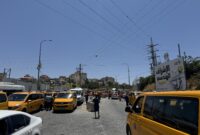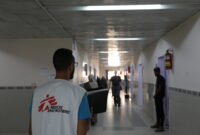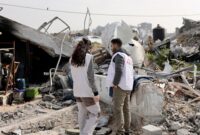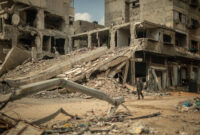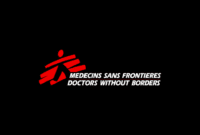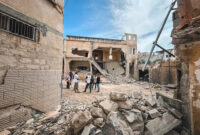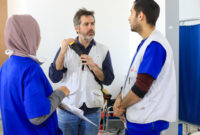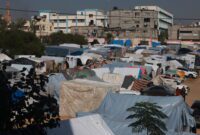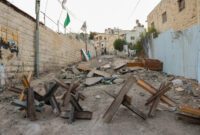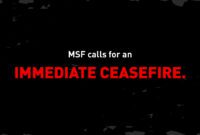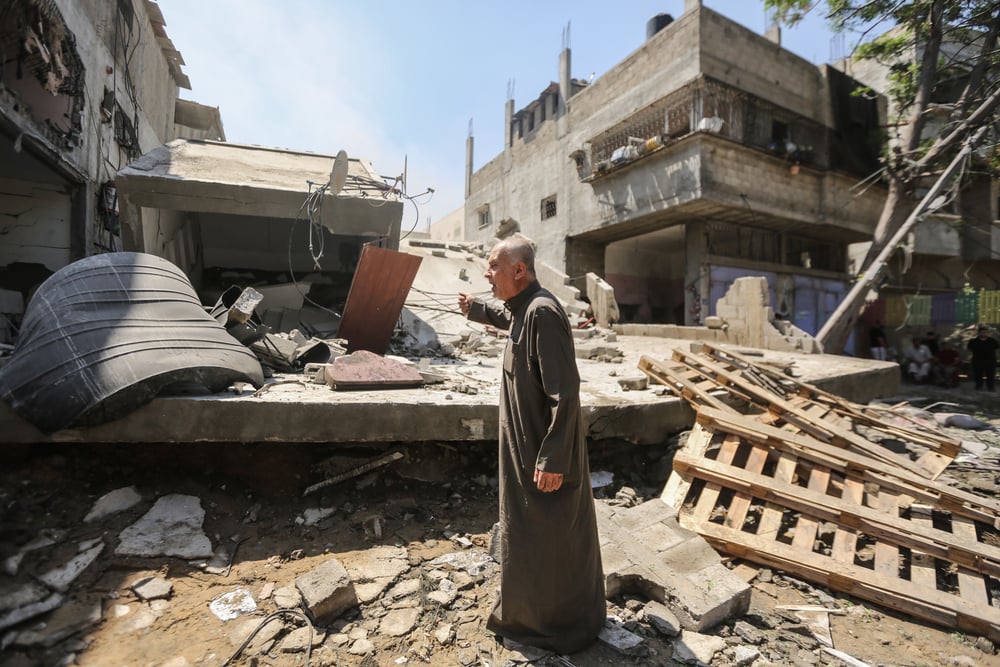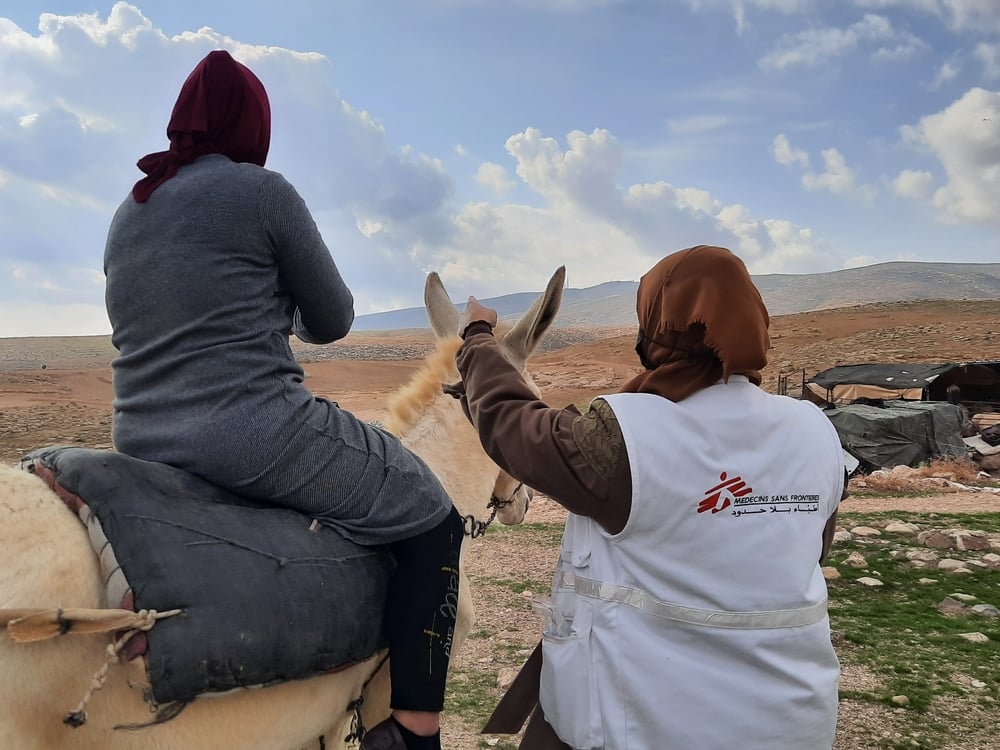Gaza: How the Israeli army besieged and attacked Nasser hospital
On the night of Feb. 14 to 15 2024, Nasser hospital, once the largest hospital in southern Gaza, was shelled by Israeli forces. The orthopaedic department was hit, killing one person and injuring eight others. After several weeks of intense fighting with Palestinian armed groups in Khan Younis, Israeli forces stormed the facility, which until then had been under siege. Doctors Without Borders/Médecins Sans Frontières (MSF) staff members working at the hospital were first-hand witnesses. Their accounts, corroborated by other sources, retrace the events leading up to the night of Feb. 14-15 and the forced evacuation of the hospital. The evidence at our disposal points to deliberate and repeated attacks by the Israeli forces against Nasser hospital, its patients and its medical staff. In November 2023, MSF documented similar attacks on Al-Shifa and Al-Quds hospitals, and on Al-Nasr children’s hospital in the north of Gaza.

Dec. 1, 2023: Fighting resumed between the Israeli army and Hamas, ending a seven-day truce that began on 24 November.
Dec. 17, 2023: MSF logbook[1]
Maternity ward targeted. A 13-year-old girl[2] killed, many casualties.
Dec. 25, 2023: MSF logbook
Heavy bombing around Nasser following evacuation order of blocks 64 and 112 beside Nasser.

Jan. 8, 2024: The Israeli army shelled an MSF shelter housing over 100 MSF staff members and their families in Khan Younis. The five-year-old daughter of one of them is killed.
Jan. 13, 2024: Thomas Lauvin, MSF project coordinator
“We’re gradually being cornered in a very restrictive perimeter in southern Gaza, with dwindling options to offer critical medical assistance, while the needs are desperately growing. As the assault on Gaza has progressed, we have had to evacuate several health facilities in the north of Gaza, then in the Middle Area. Today we are limited to mainly working in the south because we cannot work elsewhere. In short, we’re running out of hospitals. We are forced to leave patients behind.”
Jan. 15, 2024: field report by Aurélie Godard, MSF medical team leader, and Léo Cans, MSF country director, following a visit to Nasser hospital
“On Jan. 15 at around 3 p.m. an airstrike hit trucks that were unloading food at 150 metres east of the hospital. The noise was so loud that it was painful for the ears. After a few minutes, many wounded arrived at the hospital, some carried by people on foot, some by ambulances and some in private cars. Total of eight killed, including two boys four/five years old, and 80 injured, including 20 who had to undergo surgery. The next morning we visited a young boy around 10 years old who was hurt by the blast when crossing the street.
In every corridor, you can find patients lying on stretchers, on mattresses. There are a lot of internally displaced people inside the hospital. In every single corner, every waiting room or even in the courtyard, you have tents, you have people sheltering inside the hospital.
The patients in the hospital suffer – for an extremely vast majority of them – from explosive injuries, a lot of orthopaedic injuries, then having fractures plus the soft tissue around the fractures, being extremely wounded. They underwent several surgeries.
Some as well are not only wounded but as well burned after the explosion.
We saw a lot of patients coming as a family with several wounded. Some of the family members unfortunately died during the attack and the ones we saw were the ones who survived – being wounded but [having] survived.
So many of them, we saw kids, many of them are physically injured of course but psychologically traumatised as well from everything they went through.”
Jan. 18, 2024: MSF logbook
Nasser: Heavy bombing and tank shelling at night. Staff and patients very scared.
On the same day, the Israeli army bombed a residential complex housing the emergency medical team (EMT) of the International Rescue Committee (IRC) and members of Medical Aid for Palestinians (MAP) and their families. Israeli forces were aware of the presence of those teams on site. Following the attack, the EMT was forced to suspend its medical activities at Nasser Hospital.
Jan. 21, 2024: MSF logbook
Nasser hospital: totally surrounded by troops. Heavy bombing and fighting all around the hospital.
Many people were injured and killed when trying to leave the hospital. The first time the Israeli army asked everyone who heard this warning to evacuate was on Jan. 21 and 23, and most of those who evacuated returned back inside the hospital saying there are many being injured and killed at the street, Bahar street.
For me, it was not possible to leave the hospital after this date on Jan. 21 because the hospital was besieged in less than four hours.
Jan. 23, 2024: MSF logbook
New evacuation order in Khan Younis, including Nasser hospital, Al-Amal hospital and Jordanian hospital. Nasser under heavy fighting, no one can enter/exit. Still many casualties, OT [operating theatre] not functioning.
On the same day, three MSF staff members tried to evacuate the hospital, but were unable to do so. They reported gunfire and explosions all around the hospital.
Jan. 25, 2024: MSF logbook
Nasser not accessible by ambulances. Three days of fuel [left].
Jan. 26, 2024: statement by Israeli forces on ongoing military operations in Khan Younis
“The IDF [Israel Defense Forces] has been liaising with the hospital directors and medical staff, on the phone and on the ground, to ensure that the hospitals can remain operational and accessible. The IDF communicated that there is no obligation to evacuate the hospitals. On the contrary, we have reiterated the importance of safeguarding and protecting these hospitals so that they can continue providing medical services to the people of Gaza. IDF forces were briefed about the importance of operating with caution in the area of the hospitals and designated shelters prior to their operation against Hamas in this area.
Gazans who wish to move from the Nasser and Al-Amal hospitals, as many have chosen to do, can pass through the corridor on the Al-Bahar street, located on the western side of the hospitals.”

Jan. 26, 2024: MSF staff member trapped in Nasser hospital
“There was no staff left at the emergency room [ER] of Nasser hospital. There were no beds, just a few chairs and no staff, just a few nurses. We took the patients to the ER to provide first aid; we managed with what we had, tried to stop the bleeding and sort the patients there. It was a horrible event and really affected me psychologically.
(…) I went to the surgical room to receive a patient in our department and asked the few remaining staff if they could supply an abdominal gauze. They said that they didn’t have any to spare and that the ones they had were already being used on several patients. They use it once, then squeeze out the blood, wash it, sterilize it and reuse it with another patient. This is the situation in Nasser’s operating theatre, can you imagine?”

Jan. 29, 2024: MSF logbook
WHO delivered medical supply to Nasser hospital.
Jan. 30, 2024: MSF logbook
UNRWA sent fuel to Nasser.
Feb. 6, 2024: MSF logbook
Heavy fighting in Khan Younis, near Nasser. Nasser hospital still under siege. 450 wounded, 300 medical personnel, 10,000 displaced.
Feb. 8, 2024: MSF logbook
Nasser surrounded by tanks. Snipers shooting towards the hospital. One nurse injured (live bullet in the chest).
Feb. 11, 2024: MSF logbook
Nasser surrounded by tanks. Snipers shooting towards the hospital (one man shot dead at the entrance of the hospital).
Feb. 13, 2024: MSF logbook
Nasser: order of evacuation of IDPs [internally displaced people]. 402 patients, 35 on dialysis, 18 ICU, three neonatal ICU, three to four women post-delivery and just under 200 are stretcher patients. Three people were killed and 10 others injured by Israeli fire inside Nasser medical complex.
That day, an Israeli military bulldozer destroyed the gate at the northern entrance of the hospital, followed by a tank. The soldiers on site ordered displaced people to leave the hospital. A handcuffed Palestinian prisoner wearing white personal protective equipment (PPE) was later sent into the hospital by the Israeli army to order displaced people to evacuate once again. Images available online, published by several media, show that he was then executed.
Night of Feb. 14-15, 2024: MSF logbook
At night: shelling on orthopaedic department of Nasser. One person killed, eight injured. Israeli forces entered Nasser hospital destroying a lot of equipment, ambulances… Staff started to evacuate the hospital in the middle of the night. MSF staff member arrested by Israeli forces.
Feb. 15, 2024: flash update #119, United Nations Office for the Coordination of Humanitarian Affairs (OCHA)
“As of the time of writing of this update, on Feb. 15, Israeli forces reportedly entered Nasser Hospital in Khan Younis, including the maternity department, according to MoH in Gaza. The Israeli military has alleged that Hamas was holding hostages or withholding the bodies of Israelis within the compound.
The World Health Organization (WHO) Director-General, Tedros Adhanom Ghebreyesus, reported that two planned missions to reach the hospital over the past four days had been denied access and his staff have lost contact with the hospital personnel.”
Feb. 16, 2024: MSF logbook
Five patients died without appropriate healthcare due to the lack of electricity. Israeli forces arrested 20 people.
Feb. 17, 2024: MSF logbook
Israeli forces still inside Nasser. No water, no food. Evacuation of 14 patients (United Nations/Palestine Red Crescent Society). WHO team was not permitted to enter the hospital to assess the conditions of the patients and critical medical needs, despite reaching the hospital compound to deliver fuel.
Still active combat zone around, ambulances couldn’t enter the compound, patients carried out manually.
Feb. 20, 2024: Guillemette Thomas, MSF medical coordinator
“The situation in Nasser hospital is yet another example of the way healthcare facilities are being dismantled one by one in this war. Even though they were initially told they could stay inside the facility, medical staff and patients were put in danger in a place where they should have been protected.”
Feb. 21, 2024: flash update #123, United Nations Office for the Coordination of Humanitarian Affairs (OCHA)
“On Feb. 20, PRCS [Palestine Red Crescent Society] ambulances evacuated 21 injured people from Nasser hospital, also in Khan Younis, to two field hospitals in Rafah, in collaboration with WHO and OCHA. The previous two days, the same partners had evacuated 32 patients in critical condition from Nasser hospital to three other hospitals in Gaza following the siege and raid on the hospital complex by the Israeli military.”

Feb. 22, 2024: MSF logbook
Israeli forces withdrew yesterday from Nasser hospital. Evacuation of patients to Deir Al-Balah, Khan Younis and Rafah. No water, no electricity, no food. Accumulation of waste, sewage overflowing.
Feb. 27, 2024: MSF logbook
Evacuation of 72 critical cases in total. 120 patients still there. 70 health workers still detained.
March 12, 2024: BBC releases verified footage showing detained and kneeling people inside Nasser hospital after it was raided by the Israeli army.
March 17, 2024: Leo Cans, MSF country director in Palestine, describes his visits to Al-Shifa and Nasser hospitals.
One of the walls has been damaged, but it’s the only one on the fourth floor, the orthopaedic wall.
One of the MSF staff, one of the drivers, was crying during the trip when he discovered the street and the building, what was remaining. One of our other staff just arrived in the hospital, and he really almost collapsed, and couldn’t see and couldn’t talk anymore, and he really needed time to realise what Nasser is now.
According to the World Health Organization, only a third of Gaza’s hospitals are partially functional. Between Oct. 7, 2023 and March 12, 2024, there have been 410 attacks on healthcare reported by the Ministry of Health and the WHO[3].
MSF reiterates its call for an immediate, sustained ceasefire in Gaza – the only way to bring an end to the massacre of civilians and to allow humanitarian organisations to respond to the immense needs of a terrified, starving and exhausted population.
[1] MSF logbook is an internal document in which daily information relating to MSF projects management is recorded. It includes, for instance, the medical activities of teams working in Gaza’s health facilities, security incidents, patient evacuations via Rafah and fuel supplies. It reflects the exchange of information between the coordination team in Jerusalem, which keeps it up to date, and the teams in Gaza.
[2] Dina, 13 years old, amputated both legs, orphaned following an airstrike on her house, in the north of Gaza.
[3] Gaza Health Cluster, bi-weekly report, March 20, 2024


